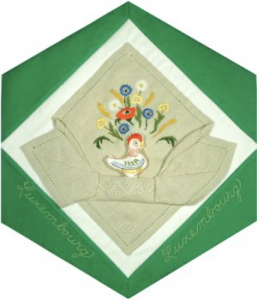Luxembourg

The Block
A napkin made of raw-linen, artfully folded and pleated, is the featured element of this block. Hand-woven from Luxembourg-grown flax, the napkin was donated by Alain Dupont as a tribute to his father’s family, who were linen producers for more than half a century. It also reflects an historical time when flax––among the world’s oldest fibre crops––was an integral part of the economy. The floral design, which includes white daisies, buttercups, blue cornflowers, and red poppies was embroidered by Greta LeCorney. Field bouquets of these flowers often filled the homes of Luxembourgers to show their resistance to World War II.
Nestled in the folds of a pocket is a three-dimensional cloth representation of a péckvillchen or coq sifleur, the small ceramic whistling bird that is traditionally given to children at Easter. These birds, sold only on Easter Monday at the Festival of Eimaischen, are also customarily exchanged between people in love.
Cultural Profile
The Grand Duchy of Luxembourg––Europe’s only remaining duchy––is a small, landlocked country tucked between Belgium, France and Germany. Its territory encompasses an area of only 2,586 square kilometres. The country is divided into two distinct regions. The northern third, known as the Eisléck or Oesling, is part of the Ardennes plateau (scene of the 1944-45 ‘Battle of the Bulge’) and consists mainly of densely forested highlands. The southern two-thirds, known as Gutland or the Good Country, are covered in rolling farmland and patches of forest. The ‘Land of the Red Earth––an area of red soil that forms the Luxembourg iron-ore basin––is located in this region’s southernmost end. The discovery of iron ore in 1850 marked a turning point for the country and brought prosperity to the entire nation. The steel industry’s significance has diminished over the years however, and today banking, manufacturing, agriculture and tourism have become the most important economic sectors. Luxembourg, one of the world’s most industrialized nations, is now a prominent figure in the European financial community. Its economic and social situation is one of the most stable in Europe, and it has the world’s highest income per capita.
Luxembourg’s population comes predominantly from German and French backgrounds, and as a direct result of the country’s historic associations with these two nations, multilingualism is widespread. Lëtzebuergesch (Luxembourgish) is the official language, as well as French and German. Indeed, proficiency in all three languages is needed to obtain a secondary school diploma in the country, while many Luxembourgers are able to speak other languages.
The people of Luxembourg are proud of their heritage and have a distinct national consciousness. Their country’s motto, “We want to remain who we are,” is inscribed throughout its capital, Luxembourg City. Music and festivals, such as Carnival, Bürgsonndeg (Bonfire Day), Octave, Schueberfouer and Broom Flower Festival, are integral parts of the culture.
Traditional handicrafts include ceramics and working with linen, which is still grown in the country.
People have been coming to Canada from Luxembourg since 1919 (even the Grand Duke’s family sought refuge here during World War II) and the 1950s saw the arrival of more than 2,000 Luxembourgers. The ability to speak more than one language eased the way for a number of new arrivals, many of whom settled in Québec. There is currently a small Luxembourg community in Montréal, which has established the Canadian Luxembourg Society to both maintain and share their culture with others. As of 2011, there were over 3,700 people from Luxembourg living in Canada.
Sponsor: Brian and Elspeth Greer
